Panna Drowning: Fears of a Volunteer
By Durga Prasad Srivastava
The first thing that comes to my mind when I think of Panna is the soaring vultures. Panna is one of the best places to watch these rare and magnificent birds as they soar freely, high in the skies. Panna is also famous for its tiger reserve and the successful tiger reintroduction program. Many rare and endangered species of wildlife are found in the Vindhya hills and grasslands of the Panna area.

Vultures in Panna
Volunteer Experience
So in 2013 when I got an opportunity to work as a volunteer in the Caracal Conservation Project initiated by Shekhar Kolipaka, a biologist studying carnivores outside the protected area landscape of Panna, my joy knew no bounds. The caracal project was initiated to safeguard a variety of endangered carnivores including the wolf and the caracal from going extinct outside PA’s.
Volunteers are engaged to collect data on wildlife and local communities. Daily work during the project period involved installing and monitoring Camera traps, setting up, walking and monitoring spoor Stations. Spoor stations are patches of forest trails cleaned and set up to register footprints of animals that move on the trails. Each day we used to walk the trails, identify the tracks to the animals and record the findings.
The volunteers were also involved in the Goat Walks. It entails walking with a goat herder throughout the day in the forest and noting down what the goats did in time and space. We also made notes and recorded the GPS locations of the habitat features and areas that we travelled.
The job of a volunteer is not just to enjoy the sights and sounds of the jungle. If you are not careful, then you can easily land up in trouble as I discovered at my cost. One day I was given the role of recording forest birds while walking with a goat herder. Other fellow volunteers had their own tasks. Goats walk fast without stopping and eat as they move. Occupied in identifying forest birds I had slowed down and the goat herders and the other volunteers had walked away without realising that I had fallen behind. Visibility in the thick teak forests can be low and most of us city bred folks can easily lose our bearings in the jungle. My shouts remained unanswered. After a long time blindly following a pugdundee without knowing where it was leading to, I came across some people. They helped me and directed me to our starting point, Jinnah Camp. Luckily all ended well.
I witnessed, experienced and learnt many new things about wildlife and humans. A week of volunteering got me hooked to this project, people, wildlife and the landscape of Panna.
I requested and was given an opportunity to carry out my dissertation work in the project between January and April 2014 and use the data that I independently collected data on
livestock herding and coral fencing strategies used by the local community. The data I collected will be used along with more information from other investigations to answer a broader question on, “How to decrease negative interactions between humans and large carnivores that live and use the same forest?
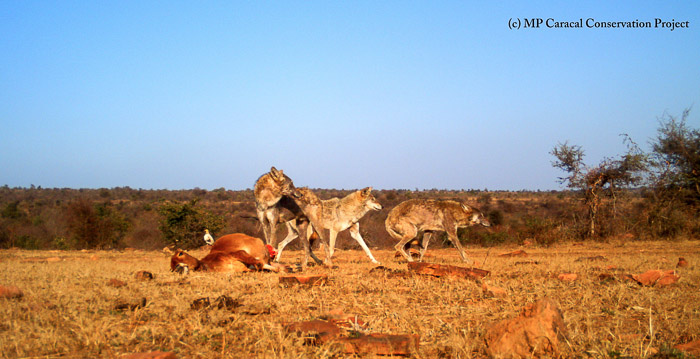
Wolves in Panna
During the period, I recorded 17 mammals species including some rare small carnivores like Asiatic wildcat (Felis sylvestris orneta), Wolves (Canis lupus pallipes), Jungle cats (Felis chaus), Rusty Spotted Cats (Prionailurus rubiginosus), 3 species of mongoose, 2 species of civets, 12 species of reptiles, 4 frog species, 4 damselfly species, 12 dragonflies, 25 butterflies and more than 140 bird species, all from multi-use, human dominated forests. From the collected data there were some interesting learnings about local communities and their role in multi-use forests
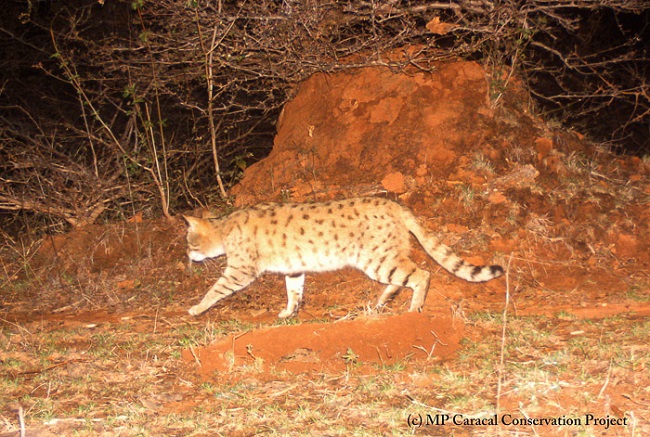
Rusty Spotted Cat
The findings reveal the impact of several interconnected social factors that are instrumental in influencing the tolerance and behaviour of local people towards forest and wildlife. For instance nearly 2750 dead cattle carcasses are discarded by villagers near village-forest fringes every year. Over 45000 cattle, both feral and those that are allowed to roam free, graze in the buffer zone areas. Both of these carcasses and cattle are easily available throughout the year in the buffer zones.
We report that the above mentioned livestock practices are grounded in local culture, influenced by age old practices and villagers see their existing practices as practical ways to deal with their cattle management issues. People see certain practical and intrinsic benefits in their existing practices and perceive such benefits as important for their survival. Because of the value people attribute to the benefits they derive from their practices they are willing to tolerant carnivores in spite of experiencing losses.
The villagers actively transfer their cultural beliefs and practices to their children and such transfer of cultural beliefs and practices is recorded at a larger landscape around Panna Tiger Reserve. Thus the recorded practices are sustainable at least in the medium term of 10-20 years. Since the observed tolerance is majorly a result of social factors (religion, beliefs, intrinsic benefits, high knowledge and familiarity on local wildlife, well versed-age old livestock management practices) and their interrelated nature, this means the above mentioned factors are providing the necessary characteristics within people to coexist with large carnivores.
The experience I got in the months while working on the caracal project helped me to successfully complete my dissertation work and graduate. On a personal level it was my great fortune to be allowed to work on the caracal project. As a result of my experience, learning and ability to apply what I learnt, I am employed by renowned organisations on their projects.
Ken-Betwa Link to Drown Panna
But today when I look back at my stint in Panna Landscape, I feel a bit of sadness because the landscape is going to change forever. The Ken-Betwa Link project is going to drown a significant portion of Panna.

Ken river flowing through Panna Tiger Reserve
The Ken River, one of perennial rivers of Madhya Pradesh, is truly the lifeline of the Reserve. It meanders around 55 km through the reserve from south to north, creating a spectacular scenery and is home of Gharial and Mugger, and other aquatic fauna. Ken is one of the least polluted rivers and a tributary of Yamuna. Panna Tiger Reserve forms part of the catchments of the Ken River. The river, though it decreases a lot in summer is never completely dry. The springs along the escarpments are perennial and are fed by aquifers draining into crevices along the escarpments. The monsoon rains and any other precipitation are the only sources of water for a large part of the park. There are also a handful of streams that retain water from the monsoon flow till early summer.
During NDA government the ambitious plan to link India’s major rivers aimed at transferring water from surplus areas to deficit area took shape. The project established a new speed of life after the BJP led NDA came into power in May 2014. The Ken-Betwa project, aims to transfer 591 million cubic metre of surplus water in Ken basin through 231.45 Km canal to Betwa river, claims to provide assured irrigation to 127,000 hectares of agricultural land in the Raisen and Vidisha district of Madhya Pradesh, along with added benefit to some 47,000 hectares area in the drought prone districts of Hamirpur and Jhansi in Uttar Pradesh and Chhattarpur and Tikamgarh in Madhya Pradesh.
The proposed dam at Dudhan near Panna on the river Ken, from which water is proposed to be divered to Betwa river basin, will require submergence of a total of over 9000 hectares of land of which 4700 hectares is part of Panna Tiger Reserve.
Flawed Environmental Impact Assessment (EIA):
The Environmental Impact Assessment which was submitted for getting clearance for the project had many flaws even though the project got green signal. First and foremost the basic water balance studies which are essential for the establishing the viability of the project, has not been carried out in EIA. It failed to see the catchment of river Ken and the frequency of drought in Ken Basin. It also ignored the downstream ecological flow of river, which will have an impact on the Ken Gariyal Sanctuary and Raneh Fall. As Ken is tributary of Yamuna and thus the Ganga River, reducing water and sediments that flows to Ganga could have deleterious effects well beyond Ken’s project area. The river also creates a flush effect downstream during monsoon helping decrease the risk of epidemics in villages along the river which are directly dependent on the river.

Streams in Panna
National Water Development Authority states only submergence of 41.4 sq km of core forest Panna, but in reality it is over 100 sq Km. It’s already noted that Panna’s small size is a factor for the long term survival of tigers, to reduce the Park size by 30% would have harmful effect on revived tiger population. The forest are important breeding and dispersal grounds and records from forest department shows that 50% of breeding tigresses are presently residing inside scheduled submergence area. There are no contiguous areas of tiger habitat that can compensate for this loss.
The scheduled submergence area under Daudhan reservoir is also a rich habitat for endangered and rare vulture species. So one project will strike a swift and deadly blow to two iconic and very important species.
There are arguments that there will be no operational activity proposed in the park area except the submergence but yet the dam is entirely within the National Park and the proposal envisages a population of 6000 or so working for perhaps 12 years to create the headworks and related work- all of whom will be in or on the periphery of the Tiger Reserve causing massive disturbance.
The flawed EIA, which assumed that the Ken river had excess water to share and ignored that it gets dry during summer, will not only lead to sureshot death of the Ken Gharial Sanctuary and Raneh Falls and the devastation of Panna but also will prove to be not viable due to unavailability of water in summer.
Joining of two rivers is not just joining of two lines in a map, it is joining of two living ecosystems. http://www.indiawilds.com/diary/indiawilds-newsletter-vol-6-issue-iv/ Without considering the viability of the project, implementation of project could be disastrous to not only core forest, Tigers and Vultures of Panna Tiger Reserve, but also for the downstream areas. It is entirely our decision to choose the development but at what cost and how viable it will be?????
Publishers Note:
The Panna landscape has got a temporary reprieve as MoEF has asked the Ken-Betwa link project to first seek wildlife clearance before environment clearance. We need to use this breathing space to write to the MoEF against this disastrous project.
You may raise your voice to protect this beautiful habitat by writing emails to the following officials:
Shri.Narendra Modi
Hon’ble Prime Minister of India,
South Block, Raisina Hill,New Delhi – 110011
http://www.pmindia.nic.in/interact_with_pm.php#
Email: pmosb@pmo.nic.in
Tel: +91-11-23012312
Fax: +91-11-23016857
Shri.Prakash Javadekar
Hon’ble Minister of State (Independent Charge)
Ministry of Environment and Forests
Room No. 560, Shastri Bhawan,
New Delhi – 110001
Email:pjavadekar@gmail.com
Tel: +91-11-23384498
Fax: +91-11-23384286(Fax)
Shri Ashok Lavasa, IAS
Secretary
Ministry of Environment and Forests
Room No. 1,Paryavaran Bhawaan,
CGO Complex,
Lodhi Road,
New Delhi – 110003
Tel: +91-11-24695262
Fax: +91-11-243695270
- In Danger: Natural & Cultural Heritage of Brihaspati Kund - 22 May,2019
- Panna Drowning: Fears of a Volunteer - 23 February,2016

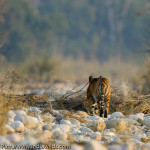

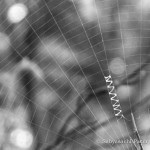



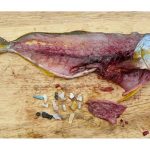
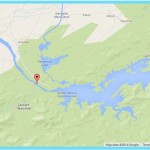



Come with “Streams in Panna”; Lovely pics of the post, Really!! Panna is my one of the dream destination to go there again and again… IndiaWilds your Diary is really hearting me in regards of Panna drowning, really i am afraid about it.. we all must to be eager to save the wildlife of everywhere..
Just wanted to note that the author is incorrect when he says only 4700 hectares of the submergence area is in the Panna Tiger Reserve. In fact although the project proponents would have us all think otherwise, almost the entire 9000 hectares are within the reserve and much of this in the core critical habitat. Also I believe you have wrongly captioned the cat photo. This is not rusty-spotted. Loved the Panna streams photo.